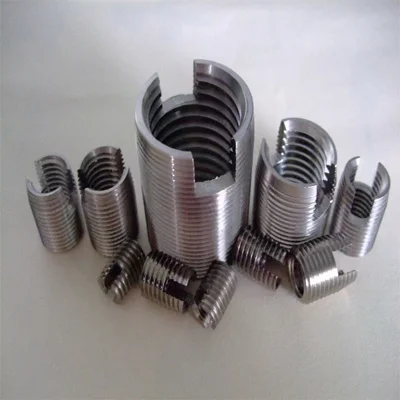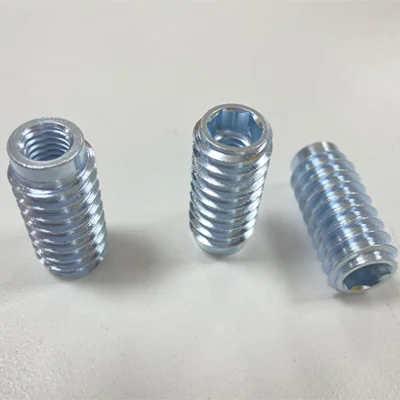caTEGORIES
Tags
How to Select Threaded Insert Materials for Wood, Plastic, and Metal

Posted: July 10, 2025
Categories: News
Overview of Common Insert Materials
Brass
Brass is a popular pick for lots of threaded insert jobs, especially in wood and plastic. It’s easy to shape, doesn’t rust much, and works great for heat and electricity. QEWIT’s brass inserts are awesome for screw-in jobs in hard woods or stretchy plastics because they’re made super smooth and precise.
Stainless Steel
When you need something tough and rust-proof, stainless steel is the way to go.
QEWIT offers stainless steel inserts in A2 and A4 types, which are extra strong and perfect for wet places, like boats, or spots with chemicals. They’re great for metal projects and heavy jobs in machines or buildings.
Aluminum
Aluminum inserts are light and don’t rust, making them good for things like airplane parts or gadgets you carry around. They’re not as tough as stainless steel, but they’re easy to put in and strong enough for most plastics or light metals.
Carbon Steel
For big, tough projects, carbon steel is the best choice. QEWIT makes carbon steel inserts with coatings like Zinc Plated Cr3, Hot Dipped Galvanized (HDG), or Zinc Flake to stop rust and keep them super strong. These are often used in cars or big metal structures.
Host Material Considerations
Wood
In woodworking, picking the right threaded insert keeps joints strong without breaking the wood.
- Screw-In Inserts: These are great for hard woods like oak or maple. Their rough outer threads hold on tight.
- Press-In Inserts (T-Nuts): These are cheap and work well in soft woods like pine, but they might not be super exact.
Material Match: Use brass or stainless steel to avoid rust from wood chemicals. QEWIT’s brass screw-in inserts have clean threads, perfect for furniture or cabinets.

Plastic
Plastics are different—some melt with heat (thermoplastics like ABS), and some stay hard (thermosets like epoxy). This changes how you put in threaded inserts.
- Heat-Set Inserts: These are awesome for thermoplastics. You heat them up, push them in, and they stick as the plastic c QEWITmakes heat-set inserts that work with machines or by hand.
- Press-In Inserts: These fit in some stiff plastics but don’t hold as strong.
- Material Match: Brassis common, but aluminum or stainless steel can work if you need lighter weight or no rust.
Metal
In metal projects, threaded inserts need to handle twisting and heavy loads.
- Rivet Nuts: These are great for thin metal sheets where you can’t cut threads.
- Thread Repair Inserts (Helicoils): These fix broken threads in metals like aluminum or steel.
Material Match: Use stainless steel or coated carbon steel to avoid rust. QEWIT offers rivet nuts and helicoils that meet DIN and ISO standards.
Performance Factors to Evaluate
Strength & Pull-Out Resistance
How strong a threaded insert is depends on its material and shape. Stainless steel and carbon steel are the toughest, while brass is strong but easier to put in. For big jobs, choose inserts with tested pull-out strength. QEWIT can give you 3.1 certifications to prove their quality.
Torque-Out Resistance
This is about how well the insert stays put when you screw something in. Inserts with flanges or bumpy (knurled) surfaces don’t spin. QEWIT’s inserts have special designs like grooves to stop twisting.
Corrosion Resistance
Where you use the insert matters. Stainless steel (especially A4) and zinc-coated carbon steel are great for wet or harsh places. For indoor stuff, brass or coated carbon steel works fine.
Weight and Thermal Compatibility
Aluminum inserts are light, so they’re good for planes or gadgets. Make sure the insert and material expand the same way in heat, especially in plastics, to avoid cracks.
Installation Method & Hole Preparation
Getting threaded inserts in right is super important:
For Wood
- Drill a hole the right size.
- Use a hex tool for screw-in inserts.
- Don’t screw too hard in soft woods to avoid messing up the threads.
For Plastic
- For heat-set inserts, use a hot tool to melt them in.
- For press-in inserts, push gently to avoid breaking the plastic.
- Molded-in insertscan go in while the plastic is made.
For Metal
- Rivet nutsneed clean holes and can be put in with hand or air tools.
- Thread repair insertsneed special tapping tools and guides. QEWIT gives drill and tap charts for exact fits.
Application-Specific Recommendations
Light-Duty Use
- Use brassinserts in wood or plastic for small jobs.
- Plasticor aluminum inserts work in places with little shaking.
Heavy-Duty Industrial Use
- Pick stainlessor carbon steel inserts with tested strength.
- QEWIT’s threaded rods and studs are great for big or custom jobs.
Cost vs Performance
- Brassinserts are cheap and easy to use.
- Stainless steeland custom carbon steel cost more but last longer.
Summary: Quick-Reference Table
| Host Material | Recommended Insert Material | Best Type | Key Benefit |
| Wood | Brass / Stainless Steel | Screw-In | Easy to put in, no rust |
| Plastic | Brass / Aluminum | Heat-Set / Press-In | Strong hold |
| Metal | Stainless / Carbon Steel | Rivet Nut / Helicoil | Handles big loads, fixes threads |
Conclusion
Choosing the right material for threaded inserts isn’t just about picking one—it’s about what your project needs, where it’ll be, and how strong it has to be. QEWIT has a big range of threaded inserts in brass, stainless steel, aluminum, and carbon steel, plus expert help and custom options. Whether you’re working with wood, plastic, or metal, QEWIT makes sure your fasteners do the job right.
FAQs
Q1: What’s the best material for threaded inserts to stop rust?
A: A4-grade stainless steel is super rust-proof, great for wet or chemical places.
Q2: Can I use the same threaded insert for wood and plastic?
A: Some brass screw-in inserts work for both, but it’s better to pick ones made for each material to hold tight.
Q3: Does QEWIT make special threaded inserts for weird projects?
A: Yup, QEWIT can make custom threaded inserts from your drawings or samples, with cool finishes and tests.


